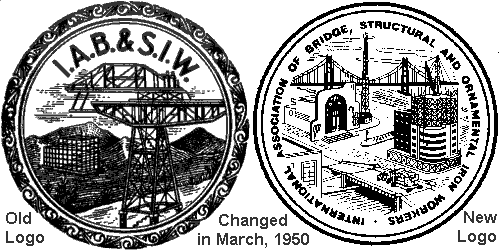|
|
|
||
|
Our History
A Union is Born
The Turbulent Years
The Conspiracy Trials
The Beginning of the
Morrin Era
The Depression and a New
Deal For Labor
World War II
Ironworkers Grow in the
1950's Part Two Part Three
John H. Lyons Jr.
Elected President
The Tradition Continues
Pathways to the 21st
Century Under The Leadership of General President Jake West
|
Part Four
The delegates elected John H. Lyons Sr. to succeed General President Morrin. It was pointed out that Lyons was well qualified to step up in the ranks due to his admirable record, during the past nine years as General Secretary and his eleven years as General Treasurer. President Lyons would become the first and only individual to serve in all three top offices in the history of the International Association (General President, General Secretary, and General Treasurer). Lyons was initiated into Local No. 9, Niagara Falls, New York in January of 1916. He later transferred to Local No. 17, Cleveland, Ohio where he was elected to several offices. In May, 1928 he was appointed General Organizer and later that year was elected as the first General Treasurer of the International Association at the 1928 Convention.
The delegates stood and bowed their heads in silent tribute to those of the International Association who made the supreme sacrifice in World War II. In the first year of the war, 18,179 members of the International Association were engaged in the war effort in one of the services including the Merchant Marine and the Sea Bees. This figure grew steadily until a peak of 30,052 was reached. Seven of the 202 men listed as having made the supreme sacrifice were missing in action while 35 were taken prisoners of war. Of those taken prisoner, 32 had been repatriated, according to records at headquarters. President Morrin said "As I see the picture today, we are standing at the crossroads. The post-war administration made a sharp turn away from the policies that had been established during the regime of the late President Roosevelt and it is now entirely up to us of the labor movement to exert every lawful means at our command to hold the gains that we had realized."
THE TRUMAN DEWEY ELECTION OF 1948 Our Union and the entire labor movement did everything in its power to get out the vote for Truman and liberal Senators and Congressmen. Truman called his policies the "Fair Deal". The polls all predicted a victory for Republican Governor Tom Dewey of New York. The election was close and several newspapers printed editions announcing that Dewey was the winner but when all the votes were counted by morning it became clear that President Truman was reelected. After Truman's victory, the Iron Workers and other labor organizations continued to demand the repeal of the Taft-Hartley Act.
The new administration presented to its members a modern a streamlined version of The Bridgemen's Magazine which henceforth would be known as "The Ironworker". The Magazine had many new features, for example, The Presidents Page, listing of local unions geographically and alphabetically instead of numerically, current schedule of wage rates, a new style of type which would make the magazine more legible, reports from General Vice-Presidents, General Organizers, and Shop Representatives. Also featured was the beginning of a blueprint course.
In 1949, President Truman was able to get a bill through Congress to raise the minimum wage from 40 cents to 75 cents an hour. This was the first increase since 1938. Truman was also able to get the Senate to hike Social Security payments. The labor movement that they would elect liberals in 1950 since conservatives of both parties were preventing the repeal of the Taft-Hartley Act. In March, 1950, General President Lyons advised the membership that a new International "seal or logo" was designed and appeared on the back cover of the March 1950 issue of The Ironworker. The new seal portrays the work of the bridgeman, structural steel erector, derrickman, reinforcing Ironworker, ornamental Ironworker, machinery mover and rigger. He said, "the old seal which we have been using for the last forty or fifty years, has long outgrown its usefulness as a symbol of the work of our trade. It is our intention to use this seal as the union label for our craft. At the present time we have over forty thousand members employed in the fabricating industry, and it is my considered opinion that the work fabricated by our members should leave the shops bearing our union label."
In her daily column, published throughout the nation, Mrs. Eleanor Roosevelt, widow of the late President, gave considerable space to the work of the Ironworker in 1950. She described her reaction to the hazards encountered by the men who erect the steel in skyscrapers. She noted their operations when seated in a dental chair in New York City and looking out an eighteenth-floor window.
Scroll to the top and click on
World War II and the Post War
Struggles
[Home]
[Officers]
[Upcoming
Events] |
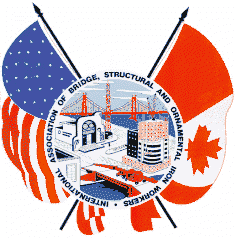
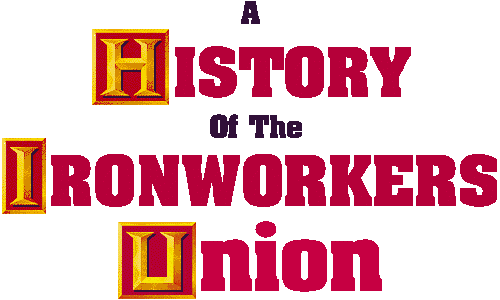
 he
Twenty-Eighth International Convention was held September 20th to the 25th
1948 at the Statler Hotel in St. Louis, Missouri. Paul J. (Paddy)
Morrin who had been General President since 1918 for a total of thirty
years decided to step down. The delegates
he
Twenty-Eighth International Convention was held September 20th to the 25th
1948 at the Statler Hotel in St. Louis, Missouri. Paul J. (Paddy)
Morrin who had been General President since 1918 for a total of thirty
years decided to step down. The delegates 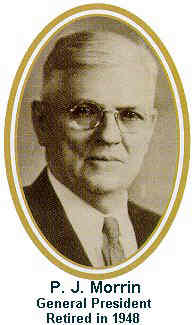 to
the 28th Convention unanimously adopted a resolution creating the office
of "President Emeritus" and elected "Paddy" to that
office for life beginning on January 1, 1949. It was pointed out in
the resolution that the organization grew from a union of 18,000 members
and a negligible treasury when he took office in 1918 to the highest
standing in the labor movement with a membership in excess of 100,000 and
a treasury of more than eight million dollars.
to
the 28th Convention unanimously adopted a resolution creating the office
of "President Emeritus" and elected "Paddy" to that
office for life beginning on January 1, 1949. It was pointed out in
the resolution that the organization grew from a union of 18,000 members
and a negligible treasury when he took office in 1918 to the highest
standing in the labor movement with a membership in excess of 100,000 and
a treasury of more than eight million dollars.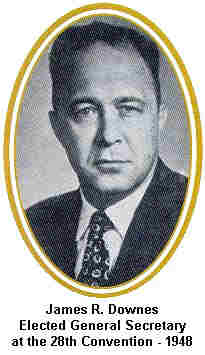 James
R. Downes was elected to replace John H. Lyons as General
Secretary. President elect Lyons nominated him for that
position. James R. Downes served as Business Agent of Local No. 550
in Canton, Ohio from 1941 to 1946, at which time he was appointed General
Organizer. President Morrin assigned him to unionize and organize
the Roanoke, Virginia area and after being successful there, he did the
same thing in North and South Carolina. James W. Lowe of
Local 11, Newark, New Jersey was also nominated, however, he lost the
election. Downes received 377 votes. Lowe received 150
votes. John J. Dempsey was reelected General Treasurer.
James
R. Downes was elected to replace John H. Lyons as General
Secretary. President elect Lyons nominated him for that
position. James R. Downes served as Business Agent of Local No. 550
in Canton, Ohio from 1941 to 1946, at which time he was appointed General
Organizer. President Morrin assigned him to unionize and organize
the Roanoke, Virginia area and after being successful there, he did the
same thing in North and South Carolina. James W. Lowe of
Local 11, Newark, New Jersey was also nominated, however, he lost the
election. Downes received 377 votes. Lowe received 150
votes. John J. Dempsey was reelected General Treasurer.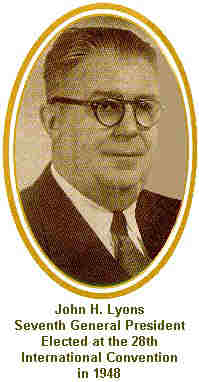 On
January 1, 1949, John H. Lyons became General President.
On
January 1, 1949, John H. Lyons became General President. The
January, 1949 issue of The Ironworker magazine featured a story and
pictures on video (television) towers and a public utilities switching sub
stations that members of International were erecting. It was pointed
out that all work of this nature including electric transmission line
towers properly comes under the jurisdiction of the Ironworkers.
The
January, 1949 issue of The Ironworker magazine featured a story and
pictures on video (television) towers and a public utilities switching sub
stations that members of International were erecting. It was pointed
out that all work of this nature including electric transmission line
towers properly comes under the jurisdiction of the Ironworkers.